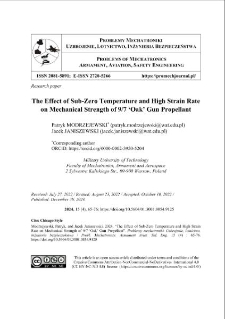Nasza Biblioteka Cyfrowa udostępnia 1 868 obiektów cyfrowych
Obiekt
Tytuł: The Effect of Sub-Zero Temperature and High Strain Rate on Mechanical Strength of 9/7 ‘Oak’ Gun Propellant ; The Effect of Sub-Zero Temperature and High Strain Rate on Mechanical Strength of 9/7 ‘Oak’ Gun Propellant
Tytuł odmienny:
Wpływ ujemnej temperatury i dużej szybkości odkształcenia na wytrzymałość mechaniczną prochu 9/7 „Dąb” ; Wpływ ujemnej temperatury i dużej szybkości odkształcenia na wytrzymałość mechaniczną prochu 9/7 „Dąb”
Współtwórca:
Jacek JANISZEWSKI ; Jacek JANISZEWSKI
Abstrakt:
The article presents the results of compressive strength testing of samples made from 9/7 ‘Oak’ (”Dąb” in Polish) gun propellant under various mechanical and thermal load conditions. The strength tests were conducted in accordance with the split-Hopkinson pressure bar (SHPB) method. The findings indicate that the mechanical behaviour of the tested gun propellant resembles that of some thermoplastic polymers. As the strain rate increases, 9/7 propellant becomes stiffer, and its compressive strength increases, but it maintains good plastic properties, i.e., material samples do not crack under dynamic load. This demonstrates, on one hand, the high sensitivity of the gun propellant to strain, and on the other, its strong resistance to brittle fracture under shock loading conditions. However, it was found that the combined effect of strain rate and lowered temperature (-50°C) leads to increased brittleness of the propellant and fracture of the samples.
;
The article presents the results of compressive strength testing of samples made from 9/7 ‘Oak’ (”Dąb” in Polish) gun propellant under various mechanical and thermal load conditions. The strength tests were conducted in accordance with the split-Hopkinson pressure bar (SHPB) method. The findings indicate that the mechanical behaviour of the tested gun propellant resembles that of some thermoplastic polymers. As the strain rate increases, 9/7 propellant becomes stiffer, and its compressive strength increases, but it maintains good plastic properties, i.e., material samples do not crack under dynamic load. This demonstrates, on one hand, the high sensitivity of the gun propellant to strain, and on the other, its strong resistance to brittle fracture under shock loading conditions. However, it was found that the combined effect of strain rate and lowered temperature (-50°C) leads to increased brittleness of the propellant and fracture of the samples.
Miejsce wydania:
Warszawa
;
Warszawa
Wydawca:
Wojskowa Akademia Techniczna ; Wojskowa Akademia Techniczna
Data utworzenia:
Data złożenia:
Data akceptacji:
Data wydania:
Rozmiar:
Identyfikator:
oai:ribes-88.man.poznan.pl:2723
Sygnatura:
doi:10.5604/01.3001.0054.9125 ; doi:10.5604/01.3001.0054.9125
ISSN elektroniczny:
ISSN drukowany:
Język:
Licencja:
kliknij tutaj, żeby przejść ; kliknij tutaj, żeby przejść
Właściciel praw:
Wojskowa Akademia Techniczna ; Wojskowa Akademia Techniczna
Strona początkowa:
Strona końcowa:
Tom:
Czasopismo:
Słowa kluczowe:
mechanical engineering, low-temperature tests, dynamic strength tests, gun propellants ; mechanical engineering, low-temperature tests, dynamic strength tests, gun propellants
Kolekcje, do których przypisany jest obiekt:
Data ostatniej modyfikacji:
17 paź 2025
Data dodania obiektu:
17 paź 2025
Liczba wyświetleń treści obiektu:
0
Wszystkie dostępne wersje tego obiektu:
https://ribes-88.man.poznan.pl/publication/3060
Wyświetl opis w formacie RDF:
Wyświetl opis w formacie OAI-PMH:
| Nazwa wydania | Data |
|---|---|
| The Effect of Sub-Zero Temperature and High Strain Rate on Mechanical Strength of 9/7 ‘Oak’ Gun Propellant | 17 paź 2025 |
Obiekty Podobne
Patryk MODRZEJEWSKI Zdzisław IDZIASZEK
Patryk MODRZEJEWSKI Jacek JANISZEWSKI

